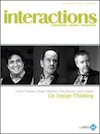Interactions Magazine – March/April 2010 issue
Here are the articles available for free online:
interactions: exploring aspects of design thinking
Richard Anderson, Jon Kolko
Popular discussion of “design thinking†has reached a point of frenzy. Unfortunately, there is often little depth to the discussion, and for many, the topic remains elusive and vague. While each issue of interactions has included articles about or reflecting the application of design thinking, this issue addresses the topic a bit more directly.
Evolution of the mind: a case for design literacy
Chris Pacione
As we come to the end of the first decade of the 21st century and what many consider the end of The Information Age, a recent flurry of books, articles, and initiatives seem to indicate that a new, pervasive mind shift is afoot. It’s called design, and like arithmetic, which was once a peripheral human aptitude until the industrial age forced it to be important for everyone, recent global changes and the heralding of a new age are positioning design as the next human literacy.
Design thinking in stereo: Brown and Martin
Paula Thornton
By 2006 an IIT Institute of Design interview with Roger Martin, titled “Designing Decisions,†told of his conversion to the concept when noting the language and behaviors of designer friends. That same year, Tim Brown presented fundamental thoughts on design thinking that also caught my attention. By the end of 2009 both Martin and Brown had released books on the topic.
Designing interactions at work: applying design to discussions, meetings and relationships
Roger Martin, Jennifer Riel
Ultimately, designers and business leaders want the same thing: transformative ideas that can be translated into real value. Yet, even with this common purpose, the interactions between design teams and business leaders often represent the biggest stumbling block to the development of breakthrough ideas. How often has a brilliant design idea been strangled in its infancy by a client who could not, or would not, “get it� How often is breakthrough innovation stopped short by number crunchers who don’t understand the process of design or the insights afforded by it? And how often do business folks moan that designers lack even the most basic understanding of cost and strategy?
From Davis to David: lessons from improvisation
Liz Danzico
Improv is extending its practicality. Designers have been adopting improvisation design methods in their own practices. Made more visible by organizations such as IDEO and Pixar and the research of people from Elizabeth Gerber at Northwestern University and Steve Portigal at Portigal Consulting, we’re seeing how improvisation can be powerful in interaction design work. With collaboration activities in particular, improv becomes especially important when untangling complex problems that require teamwork or just getting a client unstuck.
Technology first, needs last: the research-product gulf
Don Norman
Design research is great when it comes to improving existing product categories, but essentially useless when it comes to breakthroughs.
Sugared puppy dog tails: gender and design
Elizabeth Churchill
Designers are not passive bystanders in the production, reproduction, reinforcing, or challenging of cultural values. We actively create artifacts and experiences. We design products with implicit or explicit assumptions about how products will be used and by whom. We mentally simulate the product user who is part of an imagined story of the product in use – these imaginary people are drawn from our everyday lives and usually have a gender, perhaps a shape, size, age and ethnicity. Thus we embed imagined, gendered others into our designs, inadvertently reproducing cultural norms because they seem so “natural.†And so in a chain of reification and reproduction, products are wired in subtle ways that reflect and reinforce existing cultural assumptions.
The lens of feminist HCI in the context of sustainable interaction design
Shaowen Bardzell, Eli Blevis
One might identify feminism’s central tenets as commitments to agency, fulfillment, identity, equality, empowerment, and social justice. I think these commitments make feminism a natural ally to interaction design. As computers increasingly become a part of everyday life, feminism is poised to help us understand how gender identities and relations shape both the use and design of interactive technologies – and how things could be otherwise, through design.
MyMeal: an interactive user-tailored meal visualization tool for teenagers with eating disorders
Desmond Balance, Jodie Jenkinson
Since patients with eating disorders (EDs) have demonstrably abnormal perceptions of the size of food, a meal-visualization tool could help patients with EDs feel more comfortable about portions by helping them understand what appropriate food portions look like in the context of a balanced meal.
On design thinking, business, the arts, STEM …
Jon Kolko, Richard Anderson
Why [is it] only now […] that the language related to the intellectual and intangible aspects of design is beginning to catch on?





[…] Interactions Magazine – March/April 2010 issue […]